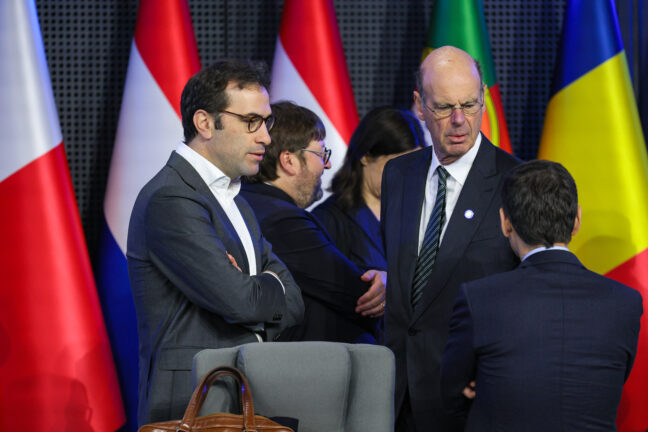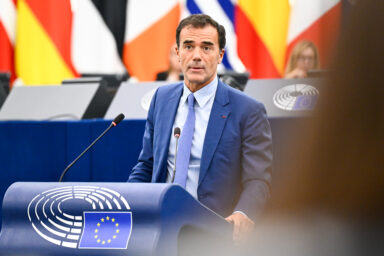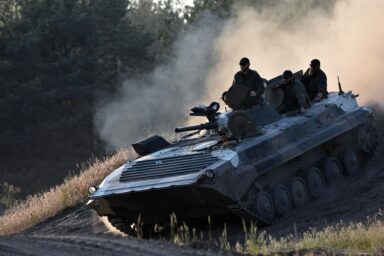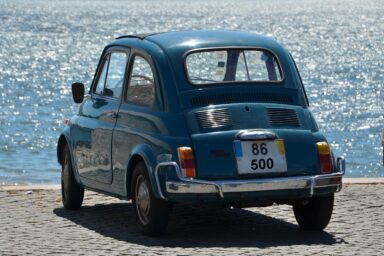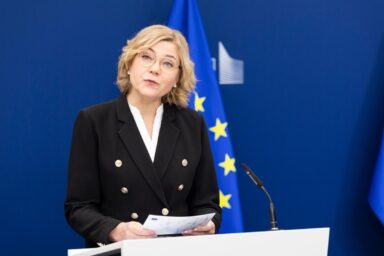When Russian tanks are sitting at your border, what do you do? You break some of your rules: forget America, welcome London, disregard Budapest. Other rules you get to keep, namely, the Germans (possibly) paying for it. That, in a nutshell, is what a new defence plan presented by Spain entails. It has found some support and some opposition, and generated some spirited debate. It has not wished away the tanks.
In April, European Union finance ministers gathered in Warsaw to confront an existential question: how to fund a continent’s defence transformation amid escalating threats from Russia and growing uncertainty over American security guarantees. At the heart of the debate lay a proposal from Spain, championing a novel financial instrument to accelerate joint military projects—a plan shaped by the Bruegel think-tank’s blueprint for a European Defence Mechanism (EDM). The initiative, designed as a temporary special-purpose vehicle, seeks to pool resources from EU and non-EU states, blending grants, loans, and frozen Russian assets to close Europe’s defence gaps.
Spain’s Economy Minister, Carlos Cuerpo framed the proposal as a “transitional solution” to fast-track investments until longer-term funding, such as embedding defence into the EU budget, materialises. “This is the moment for European solidarity (…) to support Ukraine and frontline Eastern nations,” he said, arguing that defence constitutes a “genuine European public good,”.
The mechanism would allow voluntary contributions from participating countries, with formulas for burden-sharing yet undefined, and could tap into the European Stability Mechanism (ESM)—the eurozone’s €400bn bailout fund—as well as windfall profits from €200bn in frozen Russian central bank assets.
You might be interested
A costly inefficiency
The Spanish plan dovetails with Bruegel’s EDM concept, which envisions a market-borrowing intergovernmental fund to jointly procure costly military infrastructure—command systems, satellite intelligence, next-generation jets, and strategic air defence. By keeping debt off national balance sheets, the EDM aims to placate highly indebted states while fostering a single defence market to curb fragmentation.
Europe currently fields seven types of tanks, nine howitzers, and seven infantry vehicles—a costly inefficiency Bruegel argues undermines interoperability and economies of scale. “Pooling procurement is the only way to reduce dependence on the US by 2030,” the think-tank noted, stressing the need to include Britain, a defence industrial powerhouse outside the EU.
The urgency is palpable. Russia’s war in Ukraine and Donald Trump’s return to the White House—marked by abrupt moves to end American support for Kyiv and hints of reduced NATO commitments—have jolted Europe into action. The European Commission estimates €500bn in additional defence spending is needed by 2035, with up to €800bn targeted under its ReArm Europe plan. This includes loosening EU fiscal rules to exempt defence investments from deficit limits—a measure Commissioner Valdis Dombrovskis urged members to activate by July. “There is a clear awakening in Europe regarding security,” said Polish Finance Minister Andrzej Domański, who chaired the talks. “Many countries have shifted their stance toward higher spending.”
More debt? All eyes on Merz
Yet divisions persist. France, Germany, and Belgium cautioned against creating new tools before exhausting existing ones like the European Investment Bank or the EU’s €150bn defence loan instrument. Northern frugal states, led by the Netherlands, reject joint debt outright. “More common debt is not the way forward,” insisted Dutch Finance Minister Eelco Heinen, advocating budget cuts instead.
Conversely, high-debt nations like Italy and France see pooled borrowing as unavoidable. Spain’s Mr Cuerpo called it a “no-brainer,” citing the success of the €650bn Covid recovery fund. Friedrich Merz, Germany’s likely next chancellor, recently softened his stance, signalling openness to limited joint borrowing—a shift that could tip the balance.
The EDM’s success hinges on reconciling these fault lines. While Poland’s Mr Domański reported “generally positive” reactions to Bruegel’s plan, he stressed that finalising ReArm Europe’s €800bn package remains the priority. “Ironing out the details requires close work with Ministries of Defence,” noted a senior EU official quoted by EuroWeekly News, acknowledging the complexity of aligning financial and strategic priorities.
Geopolitical equity
Spain’s parallel proposal for a temporary fund—backed by Mr Dombrovskis as fitting “ongoing discussions”—adds another layer, aiming to mobilise resources faster than the EU’s sluggish budget process allows.
Geopolitical equity also looms large. Ministers agreed that eastern frontline states bordering Russia and Belarus deserve priority in joint defence efforts. “We need to invest together (…) to bolster our economic security,” Mr Cuerpo said, framing solidarity as both a moral and strategic imperative. Yet with Spain itself allocating just 1.28 per cent of GDP to defence—the lowest in NATO—the credibility of its advocacy rests on meeting its pledge to hit the alliance’s two per cent target by 2029.
The path ahead is fraught but clear. As Mr Dombrovskis put it, the Commission is “ready to explore new options” beyond existing proposals. Whether through Bruegel’s EDM, Spain’s transitional vehicle, or ReArm Europe’s hybrid model, Europe’s security future now depends on its ability to marry financial innovation with political unity—a test as formidable as the threats it faces.
The intensifying defence debate has generated a range of comments across European media. “The EU’s Common Security and Defense Policy has increasingly sidelined democracy-related commitments in favor of security priorities. As geopolitical challenges mount, the union must restore CSDP as a meaningful part of its democracy-security toolbox,“ wrote Ricardo Farinha in a March article published by Carnegie Endowment for International Peace, a US think-tank.
Too much focus on funding alone
“Europe needs to approach their defense vulnerabilities with a sober approach that separates the short-term urgency to act and the long-term need to replace the U.S. military in Europe,“ noted Max Bergman of the American think-tank Center for Strategic and International Studies. “But the focus of European discussions is almost entirely on funding, not the tremendous structural problem of Europe’s fractured defense landscape made up of 25 or more bespoke militaries.“
To put it bluntly, these militaries are not designed to defend Europe, Mr Bergman goes on. However, that can change. “It is good that Europe is thinking big when it comes to funding, but they also need to think big when it comes to reform and integrating Europe’s forces. (But) since any European force’s purpose is to defend EU borders, it could be developed under the same legal authorities that formed the European border and coast guard agency called Frontex. Frontex’s mission is to support member states on the ground in their efforts to protect the external borders,“ Mr Bergman promotes the idea of a joint European defence force.
“The EU’s initiatives are more likely to be successful if they are sharply focused on addressing military needs and if they add real value to member-states’ national efforts. The EU should focus on those capabilities that are military priorities and that are broadly shared by the member-states,“ reads a policy brief by Centre for European Reform, a UK-EU think-tank. „Improving European air and missile defences would be a promising starting point.“
The bloc already made some baby steps in the direction in the past. Limited joint initiatives have emerged. The permanent structured cooperation (PESCO) was launched in December 2017, based on a framework agreement between the 26 participating EU countries (all EU countries except for Malta) to work together to plan, develop, and invest in military capabilities. It involves joint projects including a European Medical Command, Maritime Surveillance System, facilitating the movement of military troops and assets, mutual assistance for cyber-security and rapid response teams, and a joint EU intelligence school.
A blind spot
The European Defence Fund was launched in June 2017. It was the first use of the EU budget to co-fund defence cooperation. MEPs agreed to fund the flagship instrument with a budget of €7.9bn as part of the EU’s long-term budget (2021-2027). The Military Planning and Conduct Capability (MPCC) was established in 2017 to serve as a command and control structure and oversee military training and assistance missions.
The bloc has also strengthened cooperation with NATO on cybersecurity, joint exercises and counter-terrorism. Transatlantic coperation used to be a widely shared preference, for both practical and political reasons. During the campaign before last year’s parliamentary elections, almost all the factions (with the Left as the only outlier) included closer NATO ties among their defence priorities.
Washington’s U-turn on its decades-long defence policies, and its de facto alliance with Russia, of course, makes today’s EU challenge ever more daunting. A flurry of aforementioned EU-wide activities has emerged, resulting in the Commission ReArm Europe initiative. And while the bloc appears ready, after decades of meandering on the issue, to reach some sort of a compromise on how to pay for its own defence, time matters over perfection. “Ever since the French Revolutionaries extolled liberté, égalité and fraternité, assuming that sécurité would take care of itself, the Enlightened have had a blind spot for this stuff. Their enemies don’t,“ described it Financial Times‘ columnist Janan Ganesh with chilling accuracy.
